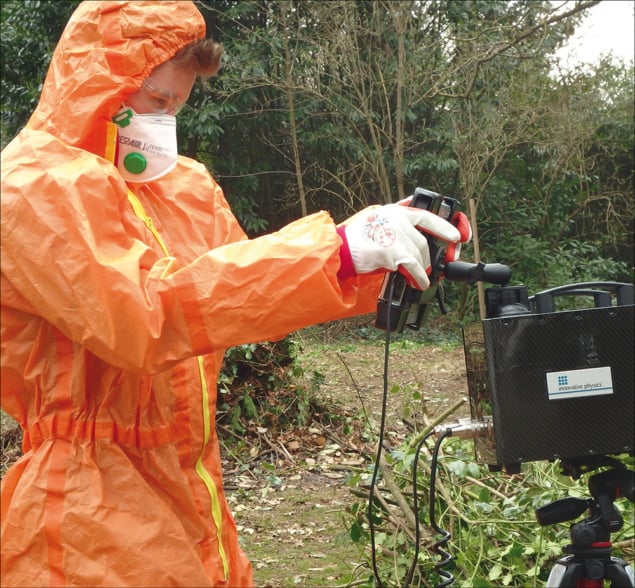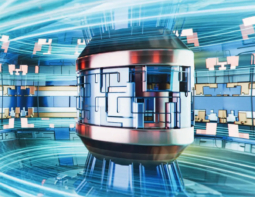Portable radiation imaging systems are making nuclear decontamination and decommissioning tasks less expensive, quicker and safer for workers, as Victoria Anderson Matthew explains

Radiation is an invisible threat. So-called “hot spots”, or areas with high levels of radiation, look no different to the human eye than lower-risk locations, and objects that have been irradiated do not smell, feel or taste different from those that have not. The invisibility of radiation is one reason why radiological incidents such as the meltdown of nuclear reactors at Chernobyl, Ukraine, in 1986 and at Fukushima, Japan, in 2011, have such a high “fear factor” among the public.
The intangible nature of dangerous radiation levels also makes it difficult for clean-up workers to determine quickly and accurately which areas require remediation. Traditionally, workers have used hand-held meters to survey small areas methodically, square centimetre by square centimetre. This process is cumbersome, and it can also mean that technicians spend unnecessarily long periods of time in dangerous environments. As a result, decontamination projects are often highly complicated and expensive, as well as potentially hazardous.
Limitations and challenges
The meltdown at the Fukushima Daiichi nuclear power station brought these problems into sharp focus. Triggered by the Tōhoku earthquake and subsequent tsunami, the disaster scattered a total of 770,000 TBq of radiological material across several Japanese prefectures. The vast geographic spread of the contamination contributed to the scale of the clean-up. In every location, teams had to thoroughly decontaminate a variety of environments and structures, including roads, houses and gardens, agricultural land and forests, water storage sites and of course Fukushima Daiichi itself.
Scientists from my company, Innovative Physics (IPL), were involved in these painstaking clean-up operations alongside partners from other organizations. The standard practice was for the top few centimetres of soil to be removed and placed in bags designed for long-term storage. This was slow and inefficient, and it quickly became evident that workers needed tools that would help them identify and locate radioactivity more efficiently (and safely) than was possible with commercially available devices.
At the time, other systems on the market used either pinhole cameras or Compton scattering to detect gamma rays. Pinhole cameras, as the name implies, allow radiation to enter a detector through a single tiny aperture. As this aperture only lets a small amount of radiation through, the signal-to-noise ratio for these devices is low – meaning that it takes a while for them to find weaker sources of radioactivity, and that people using them may be exposed to radiation in the meantime.

Devices that use Compton scattering – the interaction of a gamma ray with an electron – to determine the location of radiation also have limitations. In these systems, the electron is typically supplied by a material such as silicon, and the angle between the original position of the electron and the scattered gamma-ray photon is measured using an absorber such as cadmium telluride or cadmium zinc telluride. The Compton camera uses these measurements to determine a ring of possible origins for the incident photon, and each additional detection event builds up a more accurate picture.
This method also takes time, and the placement of the detectors in the Compton camera limits the device’s sensitivity. Even if photons from the hot spot reach the camera, some of them may be scattered at such large angles that they do not reach the second detector, making it hard to pinpoint the hot spot’s location. A typical Compton camera also uses a fish-eye lens, meaning that the distance between hot spots appears smaller than it really is due to the curvature of the lens. As a result, Compton cameras struggle to register multiple hot spots if they are too close to each other, and their image quality worsens as hot spots get closer to the edge of their field of view.
A better way
Beginning in early 2012, IPL worked closely with a Japanese customer to understand what a better “gamma camera” would look like. The Hot Spot Locator (HSL), as it is now known, was developed in the IPL’s headquarters on the Isle of Wight, UK. The way the HSL images gamma radiation is similar to the way that digital cameras image visible light. Signals from an array of high-energy radiation sensors are coupled with a coded aperture – in essence, a collection of around a dozen pinholes, which IPL’s deconvolution algorithms can interpret to create a true image of the hotspot. The HSL uses a dynamic imaging mask (DIM), which enables the coded aperture to rotate, allowing different patterns of radiological data to hit the sensor. By taking the two set patterns of radiological data and subtracting them from one another any background radiation can be removed. When these data are then overlaid onto a video camera image, the result is a near real-time image of radiation contamination.
The coded aperture design makes the HSL much more sensitive than pinhole cameras or Compton cameras of a similar size and weight, enabling it to detect levels of radiation five times lower. The HSL is also able to detect isotopes that emit radiation at energies as low as 50 keV. Both features made it well-suited for quick deployment in the rural areas around Fukushima where a complex range of radioactive isotopes is known to make up the contamination. By May 2013 a prototype device was ready for testing in contaminated areas of Fukushima Prefecture and, after it successfully identified radioactive hotspots, the first field trial unit was produced two months later.
The HSL provides an image or video of a large area, enabling workers to detect hot spots quickly and remotely. It also provides information, within minutes, about the type of radiation being emitted. Locating hot spots of radioactivity in this manner makes it easier to determine where radioactive contamination is and what its source might be (such as a leaking storage barrel). It also lets technicians focus on decontaminating highly radioactive areas first, creating a safer environment for subsequent, lower-level decontamination work.

The HSL was primarily designed to assist the Fukushima decontamination project. From this, IPL has developed a host of specific applications, highlighting the device’s versatility. Figure 1(a) shows the image generated when the HSL was placed 5 m from a drain. The background radiation in this area was 1.5 μSv/hr, and within 30 seconds, the device located a radiation hot spot of 0.18 μSv/hr – despite the contamination occurring at much lower sensitivity levels. This hot spot was quickly identified as a small shrub. Subsequent investigations showed that contaminated water had washed into the drain, and the plant’s roots were soaking it up, leading the plant itself to become contaminated.
A similar situation is shown in figure 1(b). Here, the HSL was placed 4.5 m from a bush, in an area with a background radiation of 0.5 μSv/hr. Within two minutes, the HSL identified a hot spot of 0.2 μSv/hr. In this case, contaminated water from the roof of the house was dripping onto the bush, which absorbed the contamination.
Another application for the HSL lies in reassuring end users and residents that their homes and communities really have been decontaminated to the required standard. This is essential both because radiation is invisible, and also because many Fukushima residents have become wary or distrustful of official reassurances in the wake of the environmental catastrophe. The HSLs provide clear “before and after” images that even non-radiation experts can understand, showing residents evidence of the actual levels of contamination in their areas in a way that gives them confidence in the work that has been done. The quicker the area around Fukushima can be decontaminated – and, crucially, seen to be decontaminated – the sooner people can return to their homes, and the faster the region can go back to producing crops that are safe for human consumption.
Forward looking
In the years since the Fukushima disaster, IPL has added new devices and capabilities to the HSL range. Some of these devices are designed for use by organizations that routinely process radioactive waste. Such waste is often stored in containment vessels of varying sizes before being processed and/or shipped to long-term storage facilities. In these circumstances, the HSL is faster than pinhole or Compton cameras at ascertaining whether radioactive waste is present in the storage vessels (figure 2).
All of these applications rely on the HSL’s ability to find areas of radioactive contamination quickly, in minutes rather than hours, saving money and ensuring that workers spend less time in hazardous situations. We are always interested in hearing about new technical challenges and obstacles that this technology and our R&D experience can overcome.



